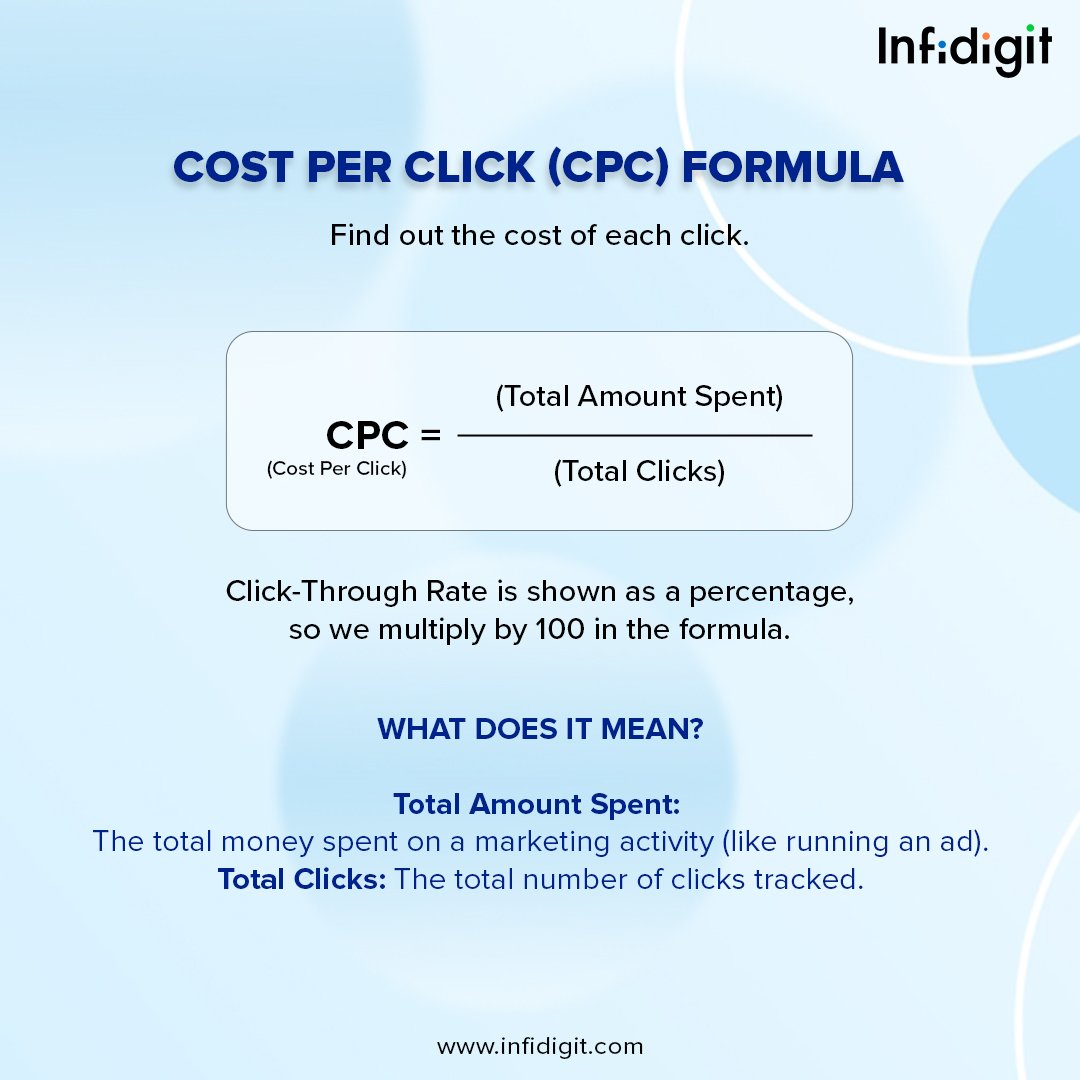Optimize Your CPC Now: Boost Your CPC with Expert SEO Strategies
View SolutionsWhat is the Cost Per Click (CPC)?
A CPC Calculator is an online tool that enables advertisers to determine the cost per click of their online advertising campaigns. This calculator simplifies the process by automating the computation of CPC based on inputs such as total ad spend and the number of clicks obtained from an advertisement. It is user-friendly and requires minimal manual intervention, which makes it a valuable asset for marketers who need to assess campaign costs quickly. Users can experiment with different scenarios by adjusting their ad spends and expected number of clicks, allowing for better ad budget planning. The calculator provides instant results, facilitating timely analysis and decision-making for ongoing campaigns. By using a CPC Calculator, advertisers can ensure they are not overpaying for clicks, streamline their budget allocation, and enhance their campaign strategies for higher cost efficiency and better outcomes.
How to find the cost per click with the formula?
To find the Cost Per Click using the formula, divide the total cost of your advertising campaign by the number of clicks your advertisement received. This simple equation clarifies the average expense for each individual who clicks on your ad. Specifically, the CPC formula is:

CPC = Total Cost of the Ad Campaign / Number of Clicks
For example, if you spent $500 on your campaign and received 250 clicks, your CPC would be $2.00, calculated as follows:
CPC = $500 / 250 clicks = $2.00 per click
To get an accurate CPC, it’s crucial to have exact numbers for both the total cost and the number of clicks. Regular tracking and analysis of these figures ensure your advertising budget is delivering the desired results.
How to Calculate CPC Using the CPC Calculator?
Calculating CPC for Pay-per-click advertisements using the CPC Calculator simplifies the process and reduces the chance of human error. You need your total ad spend and the estimated number of clicks your ad will receive. Here’s how you can use the CPC Calculator:
- Input Your Total Ad Spend: Enter the total amount you plan to spend or have spent on your advertising campaign.
- Insert Your Number of Clicks: Input your ad’s total number of clicks or the estimated number you project it to receive.
- Calculate Your CPC: With your information entered, the CPC Calculator will automatically compute CPC.
This straightforward tool not only calculates your current or projected CPC but also allows you to experiment with different scenarios. Adjust your ad spend or clicks to see how your CPC would change, giving you insight into how to tweak your campaigns for optimal cost-efficiency.
Feel free to use the calculator now and obtain instant results.
Moreover, you may want to determine the number of clicks you’d need for a desired CPC or the budget required for a target number of clicks at a specific CPC; this calculator allows those calculations, too, helping you plan more effectively for future campaigns.
Why Calculating Your CPC is Critical?
Calculating your Cost Per Click is a critical facet of any online advertising strategy. It shows you how efficiently you’re using the advertising budget and impacts your overall return on investment. Here are several reasons why CPC is a vital metric:
- Budget Management: Accurate CPC calculations help you distribute your advertising budget more effectively. By understanding what each click costs, you can decide if your spending aligns with your campaign objectives and make necessary adjustments to control costs.
- Performance Analysis: CPC serves as a diagnostic tool to measure the success of your ads. Higher costs may indicate that your ad isn’t resonating with the intended audience, while lower costs could suggest your ad is well-targeted and relevant.
- Competitive Analysis: Knowing your CPC in the context of your industry benchmarks can reveal how your campaigns stack against competitors. The insight guides you in setting realistic goals and identifying areas of improvement.
- Cost Efficiency: By monitoring your CPC, you can pursue strategies that lower your costs while maintaining or increasing the quality of your traffic, thereby increasing the value of each dollar spent.
- ROI and ROAS Insights: Ultimately, tracking and understanding CPC is about ensuring that the money you invest in advertising generates more revenue, thus maximizing ROI and ROAS.
By calculating CPC, you become empowered to make informed decisions that optimize your advertising spend for the most effective outcomes.
What Constitutes a Good CPC Rate in Different Industries?
A “good” CPC rate is not a one-size-fits-all figure; it varies by industry, targeting specifics, and campaign goals, among other factors. However, a good CPC rate generally aligns with your advertising budget while delivering a solid return on investment. To gauge whether you’re achieving a good CPC, consider the following:
- Industry Benchmark: Examine the average CPC within your industry as a starting point. Although variability across industries is considerable, knowing the standard can help you determine if your rates are competitive.
- Return on Investment: A low CPC is advantageous, but it should not come at the cost of conversion quality. To ensure profitability, evaluate the lifetime value of the customers acquired against the CPC.
- Quality Score: Google Ads, for example, uses a Quality Score as an indicator of relevance and user experience. A higher score can result in a lower CPC, and thus, striving to improve your Quality Score can indirectly signal a good CPC rate.
- Campaign Goals Alignment: Define your advertising campaign’s objectives clearly—be it brand awareness, lead generation, or sales optimization. Your CPC should match these intentions; for instance, a higher CPC might be justifiable if it achieves a broader reach for brand awareness.
- Efficiency and Conversion: Consider cost per acquisition and conversion rates alongside CPC. A good CPC rate efficiently contributes to your goal conversions without draining resources.
A thorough analysis of these factors will help you assess whether your CPC rate is beneficial for your advertising efforts.
FAQ: Everything You Need to Know About CPC
1. What is the Cost Per Click (CPC)?
Cost Per Click (CPC) is the price you pay for each click in your pay-per-click (PPC) marketing campaigns. It’s a standard measurement in online advertising that allows you to understand the cost-effectiveness of your digital marketing efforts. When you launch an ad campaign, your goal is often to maximize the number of visitors to your website while managing the costs. CPC helps you monitor that expense. Understanding this concept is key to budgeting for online advertising and can influence your return on investment (ROI).
2. How Can I Lower My CPC Effectively?
Lowering your CPC effectively involves a series of strategic actions that enhance ad relevance and targeting precision. Here are some actionable steps:
- Improve ad relevance by ensuring your ads closely match the searcher’s intent. Relevant ads resonate more with your audience, leading to a higher click-through rate, which can then decrease CPC.
- Apply targeted negative keywords to exclude unwanted traffic. This refines your audience, improves the quality of clicks, and can lead to lower CPC costs.
- Craft concise, compelling ad copy with a clear call to action. Engaging ad text influences click-through rates, which can improve Quality Scores and reduce CPC.
- Optimize landing pages to reflect your ad’s message and provide a seamless user experience. High-converting landing pages can increase Quality Scores and decrease CPC.
- Experiment with audience targeting settings to reach individuals more likely to find your offer appealing, enhancing click-through rates and lowering CPC.
- Routinely adjust bids based on keyword performance, which helps to avoid overspending on underperforming keywords and optimize your expenditure for a lower CPC.
By implementing these tips steadily and monitoring their impact, you can incrementally lower your CPC rates while maintaining or improving campaign performance.
3. Which Factors Affect CPC?
Several factors can affect your CPC, and understanding them can help you manage and optimize your ad campaigns more effectively. The following elements play a crucial role:
- Keywords and Competition: Highly competitive keywords can drive up CPC, especially in saturated markets where many advertisers bid for the same terms.
- Ad Quality and Relevance: Well-crafted and highly relevant ads can achieve a better Quality Score, which may lead to a lower CPC.
- Ad Placement: Where your ads are displayed (e.g., search engine results, social media platforms, websites) can influence the cost. Premium ad spaces typically command higher CPCs.
- Targeting Options: More precise targeting typically leads to higher CPCs as advertisers are willing to pay more to reach specific, well-defined audiences.
- Bid Strategy: Your approach, whether you opt for manual or automated bidding strategies, can significantly affect your CPC.
- Industry and Seasonal Trends: Seasonal peaks in demand or changes within the industry, such as new regulations, can impact CPC rates.
- Geographic Location: Ads targeting urban, high-competition areas may incur higher CPCs than those targeting rural or less competitive regions.
- Time of Day: CPC can fluctuate depending on when ads are displayed, with higher costs often during peak user activity hours.
By analyzing these factors and tailoring your optimization efforts accordingly, you can potentially lower your CPC and enhance the ROI of your advertising campaigns.
4. What is a Good CPM and CPC?
A good CPM (Cost Per Mille) or CPC (Cost Per Click) largely depends on the industry average, campaign objectives, and audience engagement. Generally, a lower CPC is favorable as it indicates cost-effective engagement, while CPM, varies based on desired reach and impressions. For CPM, rates around $2 to $5 are common, while a good CPC can often be under $1. However, comparing with benchmarks and historical data within your specific sector is essential for a comprehensive analysis.
5. CPC vs. CPM: Understanding the Differences
When deciding between CPC and CPM advertising models, it’s important to understand their distinct differences. With CPC, or Cost-Per-Click, advertisers pay for each click their ad receives, directly correlating cost to user engagement. This model is ideal for driving website traffic and conversions. On the other hand, CPM, or Cost-Per-Mille, charges based on every thousand impressions of an ad, regardless of clicks, making it suitable for increasing brand awareness. Consider your campaign’s objectives and whether you prioritize predictable costs or value from traffic to choose between CPC’s performance-based pricing and CPM’s broad exposure approach.
Free SEO Tools
How useful was this post?
3.8 / 5. 9








